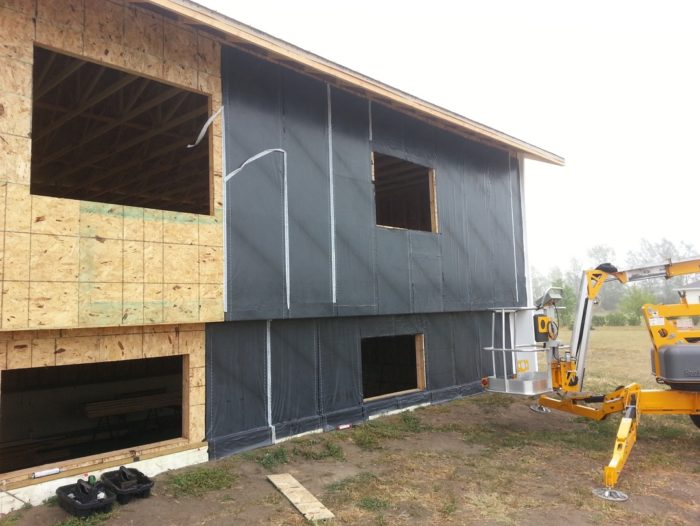
Image Credit: Adam Emter
Yes, James Timmerberg’s new house will have a water-resistive barrier (WRB) on the exterior walls. The question is which of two possible options will be best choice: Grace Ice & Water Shield, a self-adhering membrane typically used to waterproof roof decking, or Tyvek Drainwrap, a housewrap designed for areas prone to wind-driven rain.
In a Q&A post at Green Building Advisor, Timmerberg asks, “If applying a WRB under rigid foam insulation, what are the pros and cons of using Grace Ice & Water Shield compared to Tyvek Drainwrap, in terms of protecting the sheathing, serving as an air barrier, difficulty of installation, flashing details, and any other reason you might prefer one product over the other to serve as a WRB?”
Timmerberg assumes that the Ice & Water Shield will be more expensive. Is it worth the extra investment, he asks, for a 2,000-square-foot-house that will be built in Climate Zone 5? That’s the topic for this Q&A Spotlight.
These products are apples and oranges
Ice & Water Shield, as David Meiland points out, is considered a roofing product, not something that’s typically applied to exterior walls.
“These products aren’t in the same category,” he says. “If there are particular areas of your project that might benefit from a self-adhering membrane, then I would look at Vycor, but it should only be on small areas of the wall the are still vulnerable with correctly overlapped layers of more usual materials.”
Ice & Water Shield is expensive, he adds, and a “major ordeal” to apply on the entire exterior wall surface of a two-story house.
Timmerberg understands that a membrane such as Grace Ice &Water Shield is used in two construction techniques, called PERSIST and REMOTE, but Meiland points out that those building approaches…
Weekly Newsletter
Get building science and energy efficiency advice, plus special offers, in your inbox.

This article is only available to GBA Prime Members
Sign up for a free trial and get instant access to this article as well as GBA’s complete library of premium articles and construction details.
Start Free TrialAlready a member? Log in





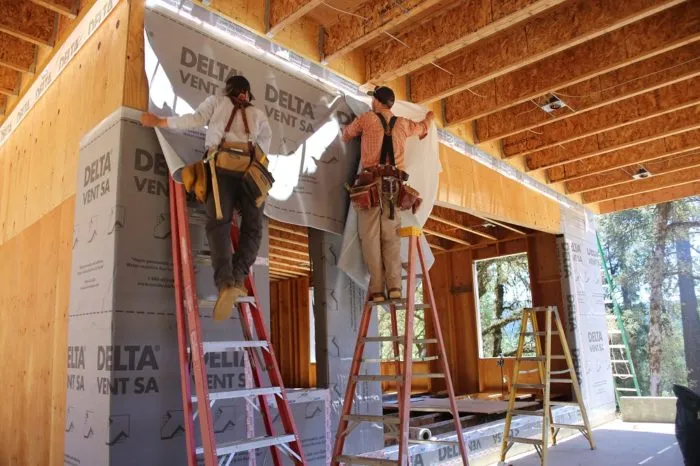
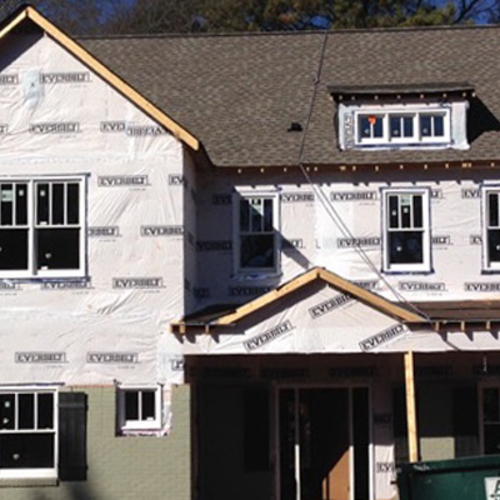
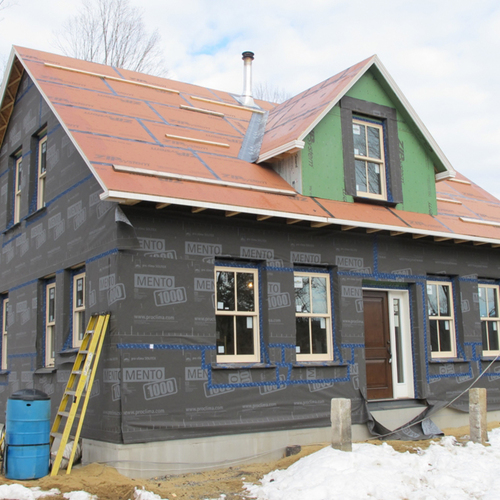
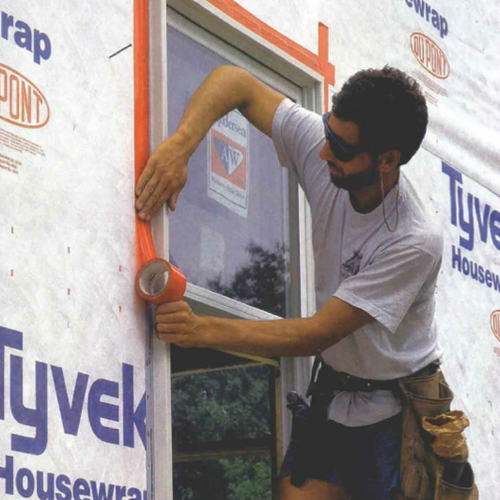






20 Comments
Further Questions.
One of the benefits of housewraps is that they are vapor permeable. I don't remember the original Q&A post but if James is using a non-permeable exterior insulation board that would pretty much negate this positive attribute of the housewrap's vapor permeability. Also it is widely stated that ice and water shield membranes are self healing. Is this true even if they are covered by thick insulation? Does the membrane only self heal or seal itself when it remelts due to higher exterior temperatures or direct sunlight to the exterior, or will it do this at lower temperatures as well? Or am I missing the point and the self healing occurs during installation?
Response to Dillon Vautrin
Dillon,
When authors say that a rubberized asphalt membrane (like Ice & Water Shield) is "self-healing," they simply mean that it is rubbery and stretchy. When you penetrate the membrane with a nail or screw, the membrane pinches around the fastener, reducing the chance of air leakage or water leakage. (Similarly, if you get a nail in your automobile tire, sometimes you don't get much leakage until you pull the nail out of the tire.)
This characteristic of a rubberized asphalt membrane is what some people call "self-healing." It doesn't depend on the sun, and it happens at cold temperatures as well as warm temperatures.
Returning to Dillon's question
If you use foil-faced foam over the sheathing, does that permit the sheathing to dry to the exterior, such that it is significantly less risky than a rubberized asphalt membrane?
Response to James Timmerberg
James,
Q. "If you use foil-faced foam over the sheathing, does that permit the sheathing to dry to the exterior?"
A. No. Like rubberized asphalt membranes, foil-faced rigid foam is a vapor barrier. If you are designing a wall assembly with either rubberized asphalt membrane or exterior foil-faced rigid foam, the wall needs to be designed to allow the sheathing to dry to the interior.
Q. "Is a wall with foil-faced foam on the exterior side of the sheathing significantly less risky than one with a rubberized asphalt membrane?"
A. The answer depends on other wall details. For either type of wall assembly to work, you need to be sure that enough insulation has been installed on the exterior side of the sheathing to make sure that the sheathing stays above the dew point during the winter.
Percentage exterior insulation to keep sheathing above dew point
The Remote Manual, if I am reading it correctly, recommends that a minimum of 43% of the insulation be on the exterior of the sheathing for climate zone 6. Three questions: (1) Are there any studies, stories, rumors, or wild speculation suggesting that 43% exterior insulation would not keep the sheathing above the dew point in zone 6? (2) If 43% works for zone 6, wouldn't it also work for zone 5? (3) Does anyone have a more specific percentage recommendation for zone 5? (The building code is silent on this issue other than mandating a minimum of either R-20 cavity insulation or 13+5.)
The IRC gives guidance on that.
The IRC is not silent on this. See the relevant portion of chapter 7:
http://publicecodes.cyberregs.com/icod/irc/2012/icod_irc_2012_7_sec002_par025.htm
For zone 6 the IRC specifies R7.5 exterior insulation for 2x4 framing, R11.25 for 2x6 framing. The most you're going to get with fiber insulation in a 2x4 cavity is R15-ish, the most in 2x6 framing is R23-ish, so per the IRC prescriptive 33% of the total R would be the minimum allowable in zone 6.
For zone 5 they specify R5 for 2x4 framing, R7.5 for 2x6, so anything over 25% of the total R would be good enough.
Response to James Timmerberg
James,
Here is a link to an article that should answer your questions: Calculating the Minimum Thickness of Rigid Foam Sheathing.
Is everyone comfortable with the IRC recommendation?
Thanks Martin and Dana.
Is everyone comfortable that a minimum of 33% exterior insulation is sufficient in a climate zone 5 wall assembly that has no ability to dry to the exterior? Having grown up in a house built to code in Chicago, with four aluminum sliding glass doors, I am receptive to the idea that code minimum might not always be good enough. I also realize that, at the end of the day, it's my sheathing that will rot if the IRC has this wrong (or wasn't intended to address the use of foil-faced polyiso), so it's my decision. But I would be very interested to hear other opinions on this issue, if there are any.
Response to James Timmerberg
James,
The issue has been extensively studied. These walls have been modeled. They have also been studied in test huts in a wide variety of climates. The test huts have lots of sensors to record the moisture content of the sheathing.
Of all the wall types studied, walls with exterior rigid foam (meeting the minimum R-value requirements shown in the IRC) have the driest wall sheathing. These walls win. The wall sheathing under the rigid foam stays dryer than the sheathing on ordinary walls with no exterior foam, and it also stays dryer than the sheathing on double-stud walls.
You should really be asking, "Is it safe to build a wood-framed wall without exterior rigid foam?" Those are the walls with damp sheathing.
One more thing
James,
I should also point out that these walls dry in both directions. Everything on the exterior side of the rigid foam (the furring strips and the siding) dries outward. Everything on the interior side of the rigid foam (the wall sheathing, studs, fluffy insulation, and drywall) dries inward.
Response to Curtis Sachse
Curtis,
Q. "What are the durability/longevity issues involved with using high-density SPF vs (whichever) WRB, and then rigid foam?"
A. If you are talking about installing spray polyurethane foam between the studs, the answer is simple: installing rigid foam on the exterior side of the wall sheathing is far preferable to installing spray foam between the studs, because (a) the sheathing stays drier, and (b) the rigid foam greatly reduces thermal bridging through the studs.
Since the sheathing is likely to be more damp with the spray foam option, the rigid foam option is likely to win the durability contest.
2 products or 1?
This is an issue I have thought a lot about, but have no practical experience. What are the durability/longevity issues involved with using high-density SPF vs (whichever) WRB, and then rigid foam. I would think a single product and contractor would make the entire project less expensive, and although the SPF has negatives in terms of off-gassing, maybe the reduction in transportation for materials and labor could offset these negatives. Is there a big durability issue with being forced into outie windows instead of the option for innie?
I am referring to using SPF in an exterior application as 1 product for both wrb and exterior insulation.
Second response to Curtis Sachse
Curtis,
I see that you have recently edited your question to indicate that you are talking about closed-cell spray foam installed on the exterior side of the wall sheathing.
Such applications of spray foam are possible, of course, but relatively rare, because of the need to install studs and stand-offs, or furring strips and stand-offs, before the spray foam is installed.
Zip Wall Sys
Im going to be building in zone 4 with a double 2x4 wall using the R-6 Zip Wall Sheathing(foam factory applied to inside zip). My veneer is going to be brick and I want to use cellulose between the double studs. Does anyone have opinions on this. Thank you.
Response to Steve Stemper
Steve,
You never want to install any rigid foam or Zip-R sheathing on the exterior side of a double-stud wall.
Here is a link to an article that explains why: Exterior Rigid Foam on Double-Stud Walls Is a No-No.
Are there any articles on the best exterior air barrier when using exterior foam?
In an attempt to anwser my own question in hopes of helping someone else.
This article addresses using foil faced polyiso as air barrier.
https://www.greenbuildingadvisor.com/article/how-to-seal-sheathing-boards
Sorry to revive this post, but I cannot seem to find this mentioned anywhere...
When using the 'REMOTE' method and opting for a rubberized membrane over the sheathing, how is this transitioned to the foundation? Is a rubberized membrane designed for a roof an acceptable foundation waterproofer, or do you need to use something like a Bituthene membrane designed for foundations? And if two different membranes are used, can they overlap to better seal the mudsill?
Since I plan to continue the rigid foam all the way down (beneath the footers even), ideally the WRB could go all the way too (perhaps over the footer as a capillary break and then connected to the sub-slab poly). I appreciate any guidance or opinions on this.
I am actually thinking of something like a Perm-A-Barrier membrane for the walls as that is what it is designed for. Wondering if that can continue down to the foundation or do I lap it over something like Bituthene when I get that far?
If it's for a slab on grade with frost walls, I don't know that I would bother with a peel and stick membrane. It's overkill. You just need a vapor retarder. A sprayed on application would likely be the easiest and most cost effective.
The original REMOTE builders were building in the harsh, wet islands of Alaska. They used the peel n' stick membranes as an air barrier and a bomb-proof WRB for their above-grade walls and roofs. These aren't issues for below-grade frost walls (concrete is a great air barrier and can stay wet forever without issue). A basement with a high water table is different story though.
Thanks Rick, this is for a daylight basement foundation, in the harsh wet inland of Wisconsin :) And the water table is about 3 feet below grade.
We'll be putting in some site drainage in addition to the foundation drainage at the footer level to help with that, which will gravity drain into an adjacent wetland/pond.
The basement will eventually be finished, so I like the idea of a solid waterproofing solution. Just not sure if I use a self-adhesive (or maybe a spray-on), if I can overlap the above-grade WRB down over the foundation waterproofing, or if that is the right way to do it.
Log in or become a member to post a comment.
Sign up Log in